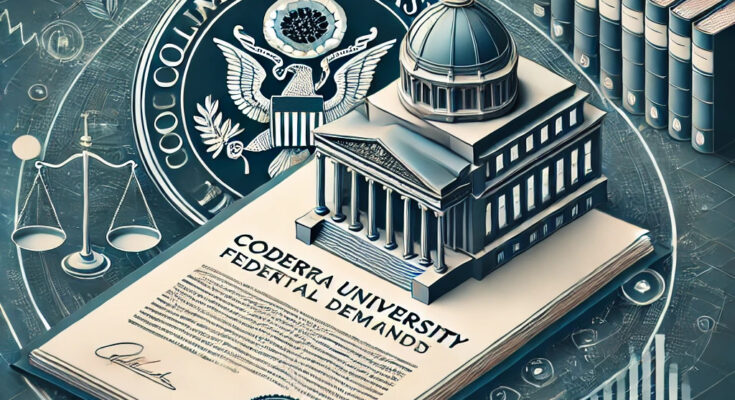Columbia University Complies with Federal Demands: A Comprehensive Analysis
Introduction
Columbia University, a beacon of academic excellence, recently found itself at a crossroads, navigating the intricate balance between institutional autonomy and federal oversight. The university’s decision to comply with specific federal demands has sparked discussions across the academic landscape, prompting questions about the implications for its future and the broader higher education community.
Background of Columbia University
Founded in 1754, Columbia University stands as one of the oldest and most prestigious institutions in the United States. Located in New York City, it has cultivated a legacy of scholarly achievement, boasting numerous Nobel laureates, pioneering research contributions, and a diverse student body that enriches its vibrant academic environment.
Federal Demands Explained
In early 2025, the federal government issued a series of demands to Columbia University, citing concerns over campus activities perceived as fostering antisemitism. The administration’s scrutiny intensified following incidents related to pro-Palestinian activism, leading to allegations that the university had not adequately addressed discriminatory behaviors. As a result, federal agencies mandated reforms to ensure compliance with civil rights laws and to maintain eligibility for federal funding.
Financial Implications
The stakes for Columbia were substantial. The university faced the potential loss of approximately $400 million in federal funding, encompassing research grants and contracts essential for its operations. This financial jeopardy underscored the critical importance of aligning institutional policies with federal expectations to safeguard vital resources.
Compliance Measures Implemented
In response to the federal directives, Columbia undertook a comprehensive review and overhaul of its policies and structures.
Policy Revisions
The university introduced new regulations aimed at curbing discriminatory practices and promoting inclusivity. These policies encompassed stricter guidelines on campus demonstrations, enhanced protocols for reporting and addressing bias incidents, and reinforced commitments to uphold free speech while preventing harassment.
Structural Changes
Significant organizational changes were also enacted. Notably, the Middle Eastern, South Asian, and African Studies Department was placed under academic receivership, a move designed to address specific concerns raised by federal authorities. This restructuring aimed to ensure that departmental activities aligned with the university’s broader commitment to nondiscrimination and academic integrity.
Impact on Academic Freedom
The compliance measures sparked a robust debate about academic freedom. Faculty members expressed apprehension that federal intervention could encroach upon scholarly independence and the open exchange of ideas. Balancing the imperative to eliminate discrimination with the preservation of academic autonomy emerged as a central challenge in this discourse.
Student and Faculty Reactions
The campus community’s reactions were mixed. Some students and faculty supported the reforms, viewing them as necessary steps toward fostering an inclusive environment. Others perceived the measures as capitulations to external pressures, fearing a chilling effect on free expression and academic inquiry.
Legal Considerations
Legal experts weighed in on the situation, highlighting the complex interplay between federal authority and institutional governance. Potential legal challenges loomed, particularly concerning the extent of federal influence over university affairs and the preservation of constitutional protections within academic settings.
Comparison with Other Institutions
Columbia’s experience is not isolated. Other universities have faced similar federal scrutiny over campus climate issues. Institutions that proactively addressed concerns through transparent policies and community engagement often navigated these challenges more effectively, offering valuable lessons for Columbia and others in the higher education sector.
Future Outlook
The long-term implications for Columbia University hinge on its ability to integrate compliance measures without compromising its core values. Successfully doing so could reinforce its reputation as a leader in both academic excellence and social responsibility. Conversely, perceived overreach or insufficient action could have lasting repercussions on its standing and operations.
Conclusion
Columbia University’s compliance with federal demands illuminates the delicate balance between adhering to regulatory requirements and preserving the foundational principles of academic freedom and institutional autonomy. This episode serves as a poignant reminder of the evolving dynamics between higher education institutions and governmental oversight in an increasingly complex societal landscape.
FAQs
1. What specific federal demands did Columbia University comply with?
Columbia addressed concerns related to campus activities perceived as fostering antisemitism by implementing policy revisions and restructuring certain academic departments to align with federal civil rights mandates.
2. How much federal funding does Columbia University receive annually?
Columbia University receives substantial federal funding, with reports indicating commitments exceeding $5 billion in grants and contracts.
3. What changes were made to university policies as a result of compliance?
The university introduced stricter guidelines on campus demonstrations, enhanced protocols for reporting bias incidents, and placed specific departments under academic receivership to ensure alignment with nondiscrimination policies.
4. How has the university community reacted to these changes?
Reactions have been mixed, with some community members supporting the reforms for promoting inclusivity, while others express concerns over potential infringements on academic freedom and free speech.
5. What are the potential long-term effects of this compliance?
Long-term effects may include strengthened institutional policies promoting inclusivity
